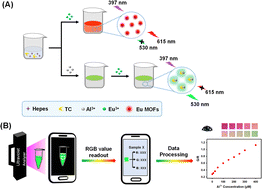A novel ratiometric sensor for fluorimetric and visual dual-mode detection of Al3+ in environmental water based on the target-regulated formation of Eu MOFs†
Abstract
Herein, a novel ratiometric sensor for fluorimetric and smartphone-assisted visual detection of Al3+ in environmental water was developed based on the target-regulated formation of Eu metal–organic frameworks (Eu MOFs). By employing 2-[4-(2-hydroxyethyl) piperazin-1-yl] ethanesulfonic acid (Hepes), Eu3+ and tetracycline (TC) as raw materials, Eu MOFs with red emission were facilely synthesized through the coordination of Eu3+ with Hepes and TC. However, upon the introduction of Al3+, a higher affinity of TC towards Al3+ resulted in the formation of a TC–Al3+ complex with green fluorescence and inhibited the generation of Eu MOFs. This led to an increase in green fluorescence and a decrease in red fluorescence accompanied by the fluorescence color of the solution changing from red to green under the illumination of the UV lamp. Thus, a ratiometric sensor for fluorimetric and the smartphone-assisted visual detection of Al3+ was established. The ratiometric sensor exhibited high sensitivity for Al3+ detection with a detection limit of 0.14 μM for fluorescence detection and 1.21 μM for visual detection. Additionally, the proposed strategy was successfully applied to detect Al3+ in the environmental water samples with satisfactory results, indicating great application prospects for environmental monitoring.



 Please wait while we load your content...
Please wait while we load your content...